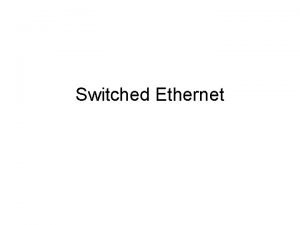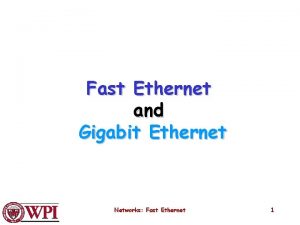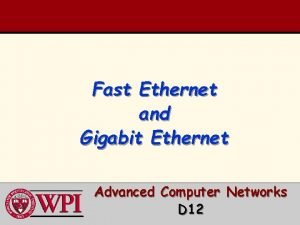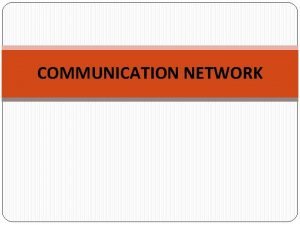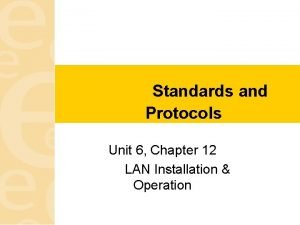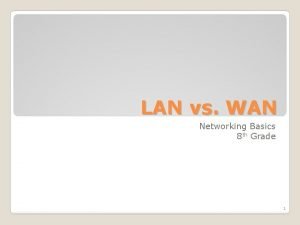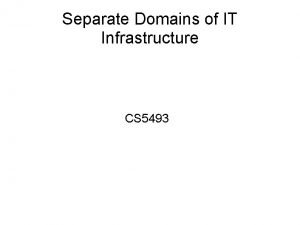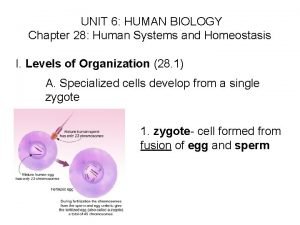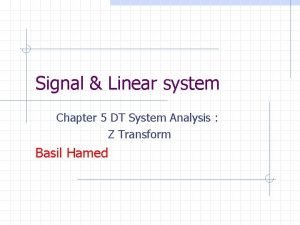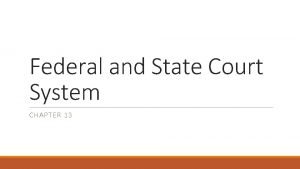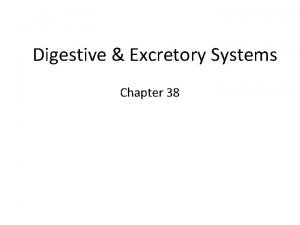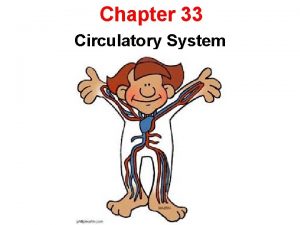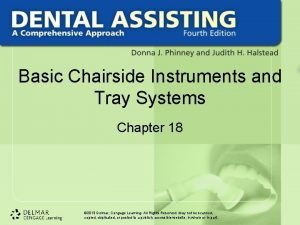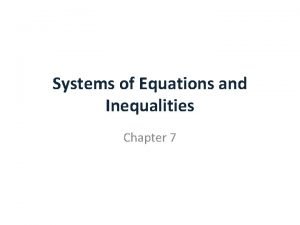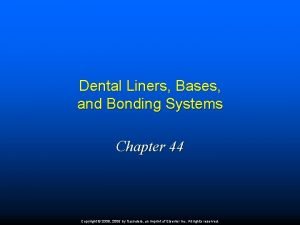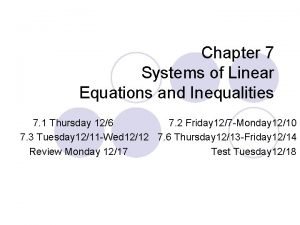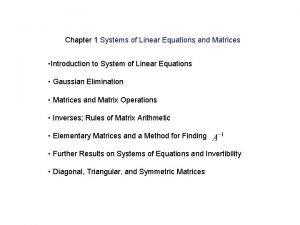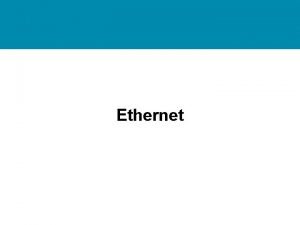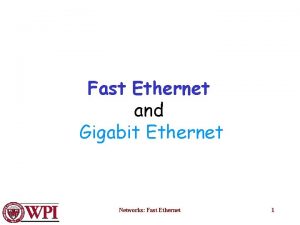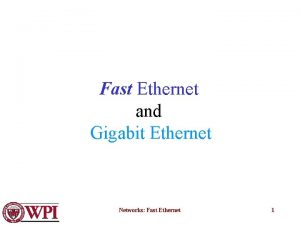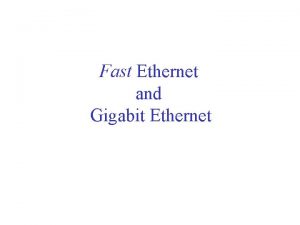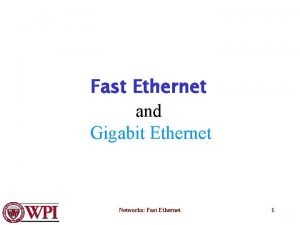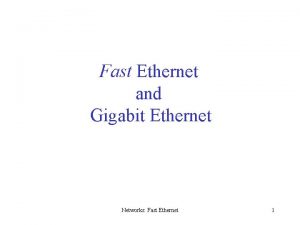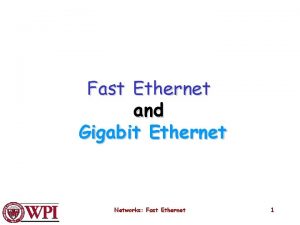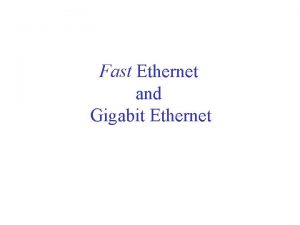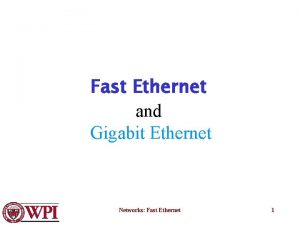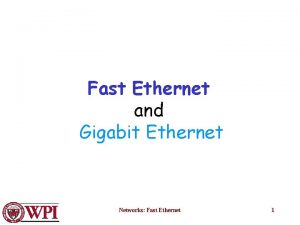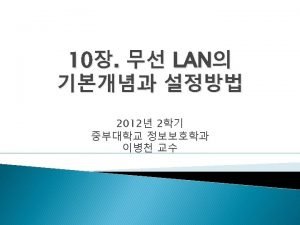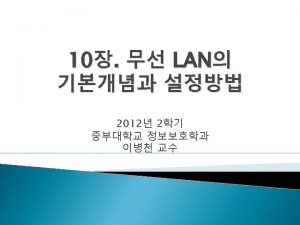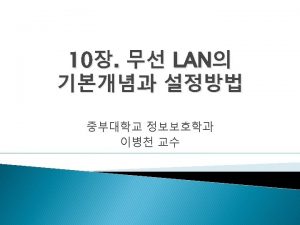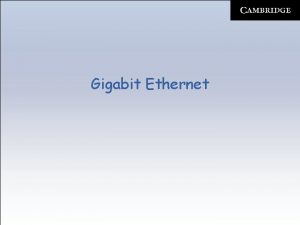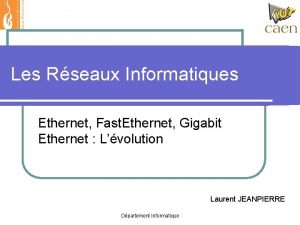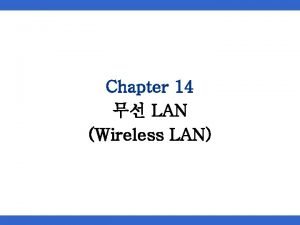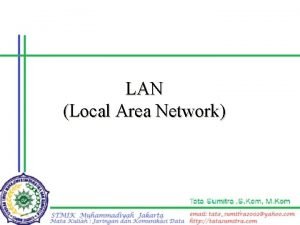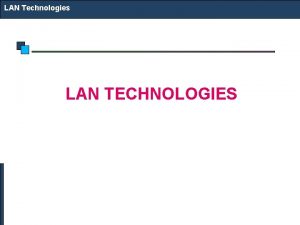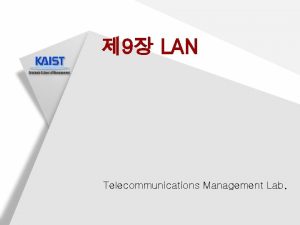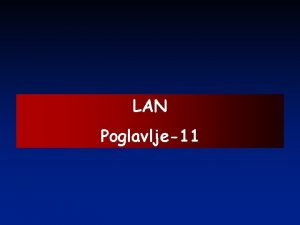Chapter 14 LAN Systems Ethernet and Fast Ethernet















































- Slides: 47

Chapter 14. LAN Systems • Ethernet and Fast Ethernet (CSMA/CD) • Token Ring and FDDI • 100 VG-Any. LAN • ATM LANs • Wireless LANs 1

Ethernet (CSMA/CD) • Precursors – ALOHA for packet radio networks • Whenever a station has a frame to send, it does so • The station then listens for an amount of time equal to the maximum possible round-trip propagation delay on the network plus a small fixed time increment • If the station hears an acknowledgement during that time, fine; Otherwise, it resends the frame • If the station fails to receive an acknowledgement after repeated transmission, it gives up. • Maximum utilization of the channel = 18% – Slotted ALOHA • Maximum utilization = 37% 2

CSMA • If a station wishing to transmit – first listens to the medium to determine if another transmission is in progress (carrier sense) – If the medium is in use, the station must wait – If the medium is idle, the station may transmit – If two or more stations attempt to transmit at about the same time, there will be a collision – To account for the collision, a station waits a reasonable amount of time, after transmitting, for an acknowledgement. If no ack. , wait a random amount of time, then retransmit 3

CSMA (cont) • 1 -persistent – used in IEEE 802. 3 – A station wishing to transmit listens to the medium – If the medium is idle, transmit – If the medium is busy, continue to listen until the channel is sensed idle; then transmit immediately 4

CSMA/CD • Inefficiency of CSMA – When two frames collide, the medium remains unusable for the duration of transmission of both damaged frames • CSMA/CD – Carrier sense for transmission – If a collision is detected during tx, transmit a brief jamming signal and then cease tx – After transmitting the jamming signal, wait a random amount of time, then attempt to transmit again (binary exponential backoff) 5

CSMA/CD (cont) • The amount of time to detect a collision is no greater than twice of the end-to-end propagation delay • Rules followed in CSMA/CD – Frames should be long enough to allow collision detection prior to the end of transmission – If shorter frames are used, then collision detection does not occur 6

CSMA/CD (ref. ) • Minimal frame size for 10 BASE 5, 10 Mbps – Typical electromagnetic wave’s speed in coaxial cable = 2. 5 x 108 m/s (table 4. 1 in textbook) – Maximum segment length = 500 m, a maximum of four repeaters length of medium = 2500 m – Minimal Ethernet frame size = 7

IEEE 802. 3 MAC Frame • Preamble: alternating 0 s and 1 s – to establish bit synchronization • Start frame delimiter – 10101011 indicates the actual start of the frame • Pad – Octets added to ensure that the frame is long enough for proper CD operation 8

IEEE 802. 3 Specification • Notation – <data rate in Mbps> <signaling method> <max. segment length in hundreds of meters> • 10 Mbps – 10 BASE 5, 10 BASE 2, 10 BASE-T, 10 BROAD 36, 10 BASE-F • 100 Mbps – 100 BASE-TX, 100 BASE-FX 9

IEEE 802. 3 10 Mbps Physical Layer 10

IEEE 802. 3 100 Mbps Specification 11

IEEE 802. 3 100 Mbps Physical Layer 12

4 B/5 B NRZ-I 13

4 B/5 B NRZ-I (cont) 14

Gigabit Ethernet • Media Access Layer – Two enhancements to CSMA/CD – 1. Carrier extension • The minimum 512 bit-times (64 octets) for 10/100 Mbps 4096 bit-times (512 octets) – 2. Frame bursting • Allows for multiple short frames to be transmitted consecutively • Physical Layer – 1000 BASE-SX, -LX, -CX, -T – Signal encoding scheme: 8 B/10 B 15

Token Ring Operation 16

IEEE 802. 5 Frame 17

IEEE 802. 5 Frame (cont) • Ending delimiter field – E bit: each station checks passing frames for errors and set the E bit to 1 • Frame status field – Destination nonexistent or not active: A=0, C=0 – Destination exists but frame not copied: A=1, C=0 – Frame received: A=1, C=1 18

A D D Token Ring Priority Scheme B A B E E C • A is sending to B • D makes a Higher priority level reservation C • A generates a higher priority token and remembers preempting lower priority 19

A D D Token Ring Priority Scheme (cont) B A B E E C • D uses the token to send data to E C • D generates a token (at current priority level) 20

Hi-pri free token A D D Token Ring Priority Scheme (cont) B A B E E C • A sees the high priority token C • A generates a token at the preempted priority level 21

Updates to Token Ring • Early Token Release (ETR) – Origin: The transmitting station must wait until the leading edge of the frame returns before issuing a token – ETR: Allows a transmitting station to release a token as soon as it completes frame transmission • Dedicated Token Ring (DTR) Token Ring switch – Define the use of stations and concentrators in the switched mode – Each link from concentrator to station is a dedicated link with immediate access possible; token passing is not used 22

IEEE 802. 5 Physical Layer 23

Disadvantage of Token Ring • Requirement for token maintenance – Loss of the token prevents further utilization of the ring – Duplication of the token can disrupt ring operation – One station must be selected as a monitor to ensure that exactly one token is on the ring and to ensure that a free token is reinserted, if necessary 24

FDDI MAC Frame In FDDI, 802. 5 priority scheme is not used. 25

FDDI MAC Protocol 26

FDDI MAC Protocol (cont) 27

FDDI Capacity Allocation • Two types of traffic – Synchronous and asynchronous • TTRT: target token-rotation time • SAi: synchronous allocation • Dmax + Fmax + Token. Time + SSAi <= TTRT – Dmax: propagation time for one complete circuit of the ring – Fmax: time required to tx a max. -length frame – Token. Time: time required to tx a token 28

FDDI Capacity Allocation (cont) • Timers – token-rotation (TRT), token-holding timer (THT) • Each station is initialized with TRT = TTRT • When a station receives the token – if the token is early • THT TRT, TRT TTRT, enable TRT – It may transmit synchronous frames for a time SAi – After tx synchronous frames, THT is enabled. The station may begin tx of asynchronous frames as long as THT > 0 29

FDDI Timed Token Protocol Timer ms 50 THT : = TRT Token captured 40 TRT : = TTRT 30 A nc 20 THT : = 0 Token released sy tr a ffi 10 10 20 30 40 c 50 60 70 80 ms 30

FDDI Synchronous Traffic Timer ms THT : = TRT Token captured 50 TRT : = TTRT 40 THT : = 0 Token released 30 Sync traffic A 20 End of guaranteed transmission time sy nc 10 10 20 30 40 tr af 50 fic 60 70 80 ms 31

Property of Timed Token Protocol • Each station will get access at least once within the pre-configured TTRT (no SA) Assume Tki : Tx time of station k for ith captured token TRTki : ith observed token rotation time for station k Prove that TRTki <= TTRT for all stations k 1 2 N Station k 32

Proof 1. Tki >= 0 for all station k and all cycles i. 2. From the timed token protocol Tki <= TTRT - TRTki Last cycle TRTki = T 1 i + T 2 i +…+ Tk-1 i + Tki-1 + Tk+1 i-1 + … + TNi-1 3. Assume for station k and cycle i, TRTki > TTRT , it means T 1 i + T 2 i +…+ Tk-1 i + Tki-1 + Tk+1 i-1 + … + TNi-1 > TTRT T 1 i + T 2 i +…+ Tk-2 i + TTRT - TRTk-1 i + Tki-1 + … + TNi-1 > TTRT T 1 i + T 2 i +…+ Tk-2 i - (T 1 i + T 2 i +…+ Tk-2 i + Tk-1 i-1 + Tki-1 +… + TNi-1 ) + Tki-1 + Tk+1 i-1 + … + TNi-1 > 0 Tk-1 i-1 < 0 ==> conflict !! Therefore TRTki <= TTRT 33

FDDI Physical Layer 34

100 VG-Any. LAN • 802. 12 Demand priority • Topology – hierarchical star • MAC – round-robin scheme with two priority levels – Single-hub network • When a station wishes to transmit a frame, it first issues a request to the central hub and then awaits permission from the hub to transmit • The central hub continually scans all of its ports for a request in round-robin fashion 35

100 VG-Any. LAN: Single-Hub Network 36

100 VG-Any. LAN: Hierarchical Network Level 1 Root repeater 1 -1 1 -2 1 2 1 -4 A k 1 -6 Level 2 repeater 1 2 B . . . 3 -1 3 -2 1 -7 n Level 2 repeater . . . 3 -k 5 -1 5 -2 5 -n 37

ATM LANs • Gateway to ATM WAN – An ATM switch acts as a router and traffic concentrator for linking a premises network complex to an ATM WAN • Backbone ATM switch – ATM switches interconnect other LANs • Workgroup ATM – End systems connect directly to an ATM switch 38

Backbone ATM LAN FDDI ***** 622 Mbps Link to other ATM LAN ***** To public ATM Network 155 Mbps 10 Mbps Ethernet ***** 155 Mbps 100 Mbps Ethernet 39

ATM LAN Hub Configuration 40

Fibre Channel • Design to combine the best features of – I/O channel – Network communications • More like traditional circuit/packet switching • Protocol architecture: 5 levels – – – FC-0 Physical Media FC-1 Transmission protocol: 8 B/10 B encoding FC-2 Framing protocol FC-3 Common services: includes multicasting FC-4 Mapping: IEEE 802, ATM, IP, SCSI 41

Wireless LANs • IEEE 802. 11 Extended Service Set (a single logical LAN) Server Distribution System (a cell) Basic service set Access point station station 42

Wireless LANs (cont) • Three types of stations – No transition – BSS-transition – ESS-transition • MAC – DFWMAC (distributed foundation wireless MAC) Contention-free service Contention service Point coordination function (PCF) Distributed coordination function (DCF) CSMA-CA Physical Layer 43

IEEE 802. 11 MAC Timing Carrier Sense Multiple Access with Collision Avoidance (CSMA-CA) 44

IEEE 802. 11 MAC Timing (cont) • SIFS (short inter-frame space) – The shortest IFS, used for all immediate response actions • PIFS (point coordination function IFS) – A mid-length IFS, used by the centralized controller in the PCF scheme when issuing polls • DIFS (distributed coordination function IFS) – The longest IFS, used as a minimum delay for asynchronous frames contending for access 45

IEEE 802. 11 MAC Timing (cont) • SIFS is used for – Acknowledgment (ACK) • MAC-level ACK provides for efficient collision recovery – Clear to send (CTS) • Sender sends Request to Send (RTS) frame • If receiver is ready to receive, responds with a CTS frame • All other stations defer using the medium until they see a corresponding CTS, or timeout – Poll response • For PCF 46

IEEE 802. 11 MAC Timing (cont) 47
 Acid fast and non acid fast bacteria
Acid fast and non acid fast bacteria Example of acid-fast bacteria
Example of acid-fast bacteria Switched ethernet vs shared ethernet
Switched ethernet vs shared ethernet Unit 5 can you swim lesson 1
Unit 5 can you swim lesson 1 Fast ethernet network
Fast ethernet network Fast ethernet in computer networks
Fast ethernet in computer networks Ethernet code b
Ethernet code b Power point ethernet
Power point ethernet Fast ethernet in computer networks
Fast ethernet in computer networks Decision support systems and intelligent systems
Decision support systems and intelligent systems Fast food chapter 15
Fast food chapter 15 Lactic acid fermentation sauerkraut
Lactic acid fermentation sauerkraut Fast food chapter 19
Fast food chapter 19 Fast food chapter 18
Fast food chapter 18 Chapter 24 the immune and lymphatic systems and cancer
Chapter 24 the immune and lymphatic systems and cancer What empties into the left subclavian vein
What empties into the left subclavian vein Dicapine
Dicapine Embedded systems vs cyber physical systems
Embedded systems vs cyber physical systems Elegant systems
Elegant systems Characteristics of lan
Characteristics of lan Lan and wan difference
Lan and wan difference Lan standards and protocols
Lan standards and protocols Wan and lan
Wan and lan Lan v wan
Lan v wan Lan switching and wireless
Lan switching and wireless 7 domains of it infrastructure
7 domains of it infrastructure Token ring
Token ring Chapter 28 human systems and homeostasis
Chapter 28 human systems and homeostasis Signals and systems oppenheim solutions chapter 5
Signals and systems oppenheim solutions chapter 5 Chapter 13 federal and state court systems
Chapter 13 federal and state court systems Chapter 2 economic systems and decision making answer key
Chapter 2 economic systems and decision making answer key Chapter 38 digestive and excretory systems answer key
Chapter 38 digestive and excretory systems answer key Chapter 39 endocrine and reproductive systems
Chapter 39 endocrine and reproductive systems Chapter 36 skeletal muscular and integumentary systems
Chapter 36 skeletal muscular and integumentary systems Chapter 33 circulatory and respiratory systems
Chapter 33 circulatory and respiratory systems Chapter 2 economic systems and decision making
Chapter 2 economic systems and decision making Water and aqueous systems worksheet answers
Water and aqueous systems worksheet answers Chapter 15 water and aqueous systems answer key
Chapter 15 water and aqueous systems answer key Chapter 14 the skeletal muscular and nervous systems
Chapter 14 the skeletal muscular and nervous systems Non cutting dental instruments
Non cutting dental instruments Chapter 15 water and aqueous systems answer key
Chapter 15 water and aqueous systems answer key Chapter 7 systems of equations and inequalities answers
Chapter 7 systems of equations and inequalities answers What is an example of enamel bonding
What is an example of enamel bonding Chapter 2 economic systems and decision making answer key
Chapter 2 economic systems and decision making answer key Bonding system materials
Bonding system materials Chapter 7 systems of equations and inequalities answers
Chapter 7 systems of equations and inequalities answers Chapter 4 ethical and social issues in information systems
Chapter 4 ethical and social issues in information systems Homogeneous system of linear equations matrix
Homogeneous system of linear equations matrix


